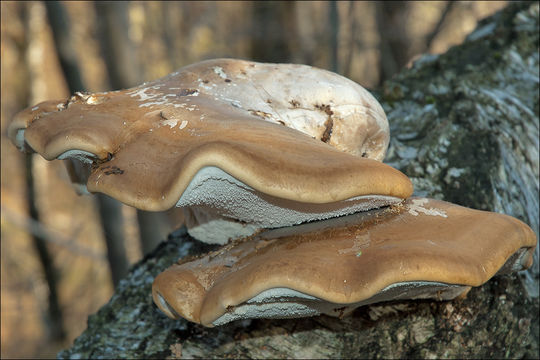Image of birch polypore

Description:
Slo.: brezova odpadljivka - Habitat: light primary wood on former pastures in a group of Betula pendula, slightly inclined mountain slope, southwest aspect; cretaceous clastic rock (flysh) bedrock; in half shade, quite humid place; partly protected from direct rain by tree canopies; average precipitations ~ 3.000 mm/year, average temperature 8-10 deg C, elevation 500 m (1.650 feet), alpine phytogeographical region. Substratum: dead standing and fallen trunks of Betula pendula as well as rarely on stumps. Comments: Birch (Betula pendula var. pendula) is not a very common tree in my surrounding. It appears only here and there, rarely in larger stands. However, wherever it grows Piptoporus betulinus is frequently present. Hence this polypore is quite common and easy to find. Piptoporus betulinus is an annual polypore but its dead sporocarps remain present sometimes several years, before they totally disintegrate. It is a very nice fungus, easy to recognize in spite of the fact that it appears in any imaginable shape and size. Its pilei have smooth, lacquer surface when young and very light context. It can scarcely be mistaken. The fungus is at first a parasite attacking only already weakened trees. Later it becomes saprophyte causing brown root of the wood. This means, it disintegrates mainly cellulose. The attacked wood looses much of its specific weight, sometimes even 70% of its initial value. The remaining brown lignin is often disintegrated by white root fungi cohabitating on the same trunks like Daedaleopsis confragosa, Daedaleopsis tricolor, Lenzites betulina and Fomes fomentarius (Ref.:1), which complete wood disintegration process. A piece of this species was carried by 'tzi', the 5.300 year old mummy of ice man found high in the Alps in 1991. For what purpose these people used it is not known with certainty. Many fruitbodies were present at the place of this observation. The largest one had 30 cm across. Ref.: (1) G.J. Krieglsteiner (Hrsg.), Die Grosspilze Baden-Wrttembergs, Band 1., Ulmer (2000), p 599. (2) J. Breitenbach, F. Kraenzlin, Eds., Fungi of Switzerland, Vol.2. Verlag Mykologia (1986)) p 318. (3) M. Bon, Parey's Buch der Pilze, Kosmos (2005), p 316. (4) R. Phillips, Mushrooms, Macmillan (2006), p 307.
Included On The Following Pages:
- Life (biota)
- Cellular
- Eukaryota (eukaryotes)
- Opisthokonta (opisthokonts)
- Nucletmycea
- Fungi (mushrooms, lichens, molds, yeasts and relatives)
- Dikarya
- Basidiomycota (basidiomycete fungi)
- Agaricomycetes (mushrooms, bracket fungi, puffballs, and allies)
- Polyporales (Hoof Fungi)
- Fomitopsidaceae (bracket polypores)
- Fomitopsis betulina (birch polypore)
This image is not featured in any collections.
Source Information
- license
- cc-by-nc-sa-3.0
- copyright
- 2016 Dr. Amadej Trnkoczy
- photographer
- Dr. Amadej Trnkoczy
- original
- original media file
- visit source
- partner site
- CalPhotos
- ID


